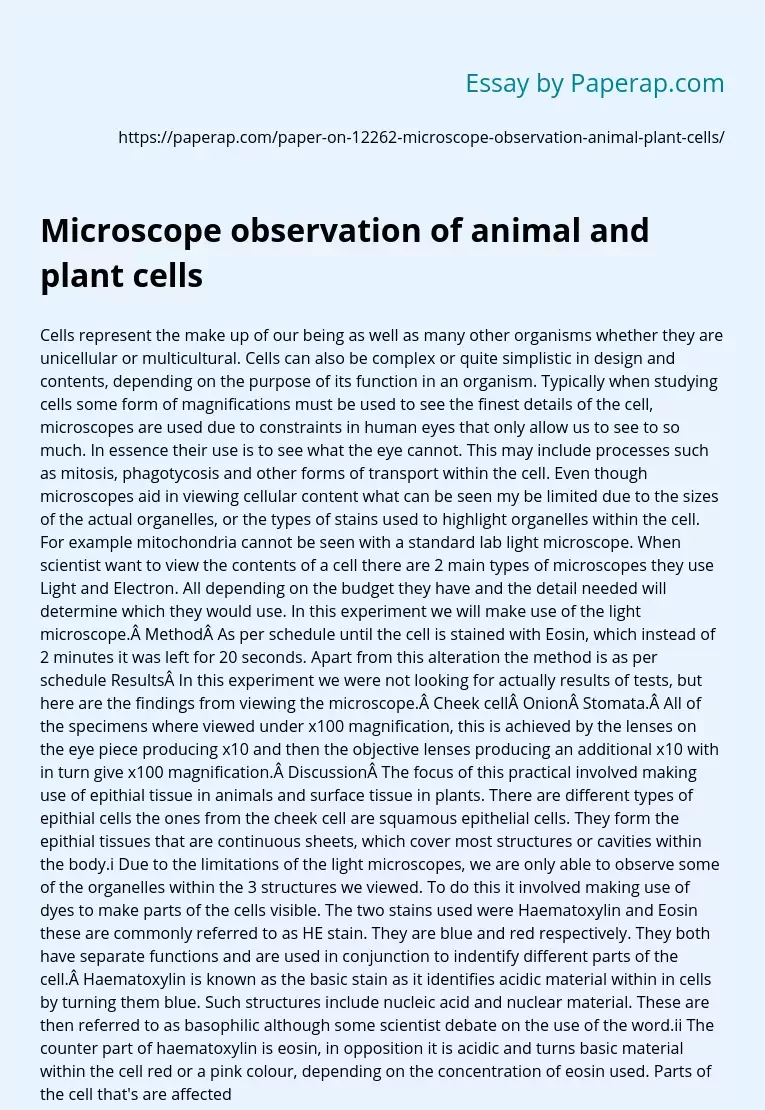Microscope observation of animal and plant cells
Cells represent the make up of our being as well as many other organisms whether they are unicellular or multicultural. Cells can also be complex or quite simplistic in design and contents, depending on the purpose of its function in an organism. Typically when studying cells some form of magnifications must be used to see the finest details of the cell, microscopes are used due to constraints in human eyes that only allow us to see to so much. In essence their use is to see what the eye cannot.
This may include processes such as mitosis, phagotycosis and other forms of transport within the cell. Even though microscopes aid in viewing cellular content what can be seen my be limited due to the sizes of the actual organelles, or the types of stains used to highlight organelles within the cell. For example mitochondria cannot be seen with a standard lab light microscope.
When scientist want to view the contents of a cell there are 2 main types of microscopes they use Light and Electron.
All depending on the budget they have and the detail needed will determine which they would use. In this experiment we will make use of the light microscope. Method As per schedule until the cell is stained with Eosin, which instead of 2 minutes it was left for 20 seconds. Apart from this alteration the method is as per schedule
Results In this experiment we were not looking for actually results of tests, but here are the findings from viewing the microscope.
Cheek cell Onion Stomata. All of the specimens where viewed under x100 magnification, this is achieved by the lenses on the eye piece producing x10 and then the objective lenses producing an additional x10 with in turn give x100 magnification. Discussion The focus of this practical involved making use of epithial tissue in animals and surface tissue in plants. There are different types of epithial cells the ones from the cheek cell are squamous epithelial cells. They form the epithial tissues that are continuous sheets, which cover most structures or cavities within the body.i
Due to the limitations of the light microscopes, we are only able to observe some of the organelles within the 3 structures we viewed. To do this it involved making use of dyes to make parts of the cells visible. The two stains used were Haematoxylin and Eosin these are commonly referred to as HE stain. They are blue and red respectively. They both have separate functions and are used in conjunction to indentify different parts of the cell. Haematoxylin is known as the basic stain as it identifies acidic material within in cells by turning them blue. Such structures include nucleic acid and nuclear material. These are then referred to as basophilic although some scientist debate on the use of the word.ii
The counter part of haematoxylin is eosin, in opposition it is acidic and turns basic material within the cell red or a pink colour, depending on the concentration of eosin used. Parts of the cell that’s are affected by eosin include the cytoplasm, because of its basic nature. Haematoxylin is not really regarded as an actually a dye although this is debatable by some, where as eosin is an acid dye. Haematoxylin is able to develop colour-like properties when oxidized. Because of their different properties they both sow their importance in staining because of their characteristics. As stated within the practical organelles were limited to what could be seen with the light microscope. An electron microscope would have highlighted organelles such as Golgi body, mitochondria etc. in three dimensions.
Reference:
Barbour, M. et al. (1997) Biology. London: Collins Educational
http://protocolsonline.com/histology/haematoxylin-eosin-he-staining/ accessed on 17/11/2010
http://www.lab.anhb.uwa.edu.au/mb140/MoreAbout/stains.html accessed on 17/11/2010
Microscope observation of animal and plant cells. (2018, Jan 09). Retrieved from https://paperap.com/paper-on-12262-microscope-observation-animal-plant-cells/

